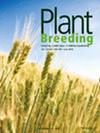辣椒幼苗向成苗过渡的异常与杂交弱化有关
IF 1.8
4区 农林科学
Q2 AGRONOMY
引用次数: 0
摘要
在辣椒(Capsicum annuum)×辣椒(Capsicum chinense)或辣椒(C. annuum)×辣椒(Capsicum frutescens)杂交的 F1 代杂交种中观察到了弱化现象。这种现象的形态特征是新叶在发芽后约 30 天(DAG)停止生长。我们想知道为什么这种现象会出现在生长中期,并研究了辣椒杂种优势与幼苗到成苗(JA)阶段过渡之间的关系。两个亲本的叶柄/叶片长度比、叶片侧脉和气孔数量、甲苯胺蓝染色的叶片表皮细胞颜色以及 miR156 和 miR172 的表达等性状在无性繁殖初期发生了变化。根据在无性繁殖初期观察到的变化,C. annuum 和 C. chinense 被转入成株期 28 DAG。然而,F1 杂交种在任何时间点都没有表现出成虫期的特征。此外,在大约 35 DAG 时观察到杂交弱的表型,此时 F1 杂交种被推定达到 JA 过渡阶段。有人认为,JA 转换与辣椒杂种优势弱有关。本文章由计算机程序翻译,如有差异,请以英文原文为准。
Abnormalities in juvenile‐to‐adult transition are associated with hybrid weakness in chili pepper (Capsicum)
Weakness was observed in the F1 hybrids of crosses between Capsicum annuum Capsicum chinense C. annuum Capsicum frutescens Capsicum hybrid weakness and the juvenile‐to‐adult (JA) phase transition. Traits that changed during the early vegetative phase in both parents were the petiole/leaf length ratio, number of leaf lateral veins and stomata, colour of epidermal cells in leaves stained with toluidine blue and expression of miR156 and miR172 . Based on the changes observed during the early vegetative phase, C. annuum C. chinense 1 hybrids did not show characteristics of the adult phase at any time point. Furthermore, the phenotypes of hybrid weakness were observed at approximately 35 DAG, when F1 hybrids were presumed to reach the JA transition phase. It has been suggested that the JA transition is involved in Capsicum hybrid weakness.
求助全文
通过发布文献求助,成功后即可免费获取论文全文。
去求助
来源期刊

Plant Breeding
农林科学-农艺学
CiteScore
4.40
自引率
5.00%
发文量
74
审稿时长
3.0 months
期刊介绍:
PLANT BREEDING publishes full-length original manuscripts and review articles on all aspects of plant improvement, breeding methodologies, and genetics to include qualitative and quantitative inheritance and genomics of major crop species. PLANT BREEDING provides readers with cutting-edge information on use of molecular techniques and genomics as they relate to improving gain from selection. Since its subject matter embraces all aspects of crop improvement, its content is sought after by both industry and academia. Fields of interest: Genetics of cultivated plants as well as research in practical plant breeding.
 求助内容:
求助内容: 应助结果提醒方式:
应助结果提醒方式:


